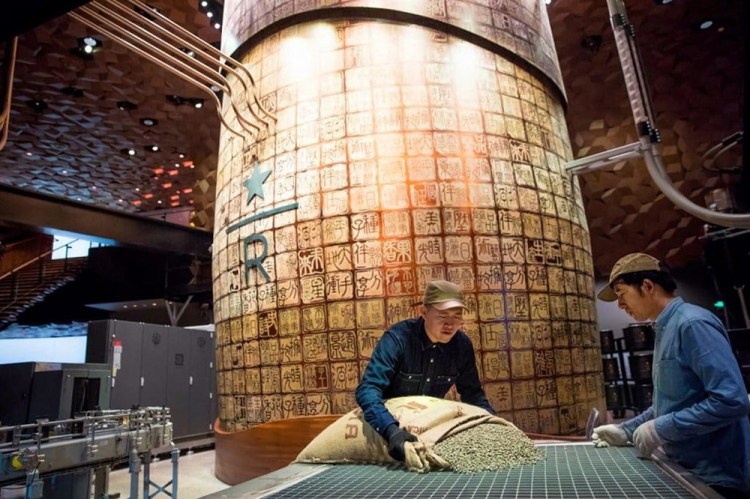Starbucks once made waves with the indulgent sizes of some of its drinks, such as the Trenta, which contains a staggering 31 ounces of joe. Now, as part of the company’s aggressive expansion in China, the Seattle-based coffee retailer opened its largest store in the world: a nearly 30,000-square foot compound that does much more than simply serve coffee.
The new Starbucks Reserve Roastery, which opened Tuesday in Shanghai, is the first non-U.S. location of a new series of shops designed to offer a more “immersive” experience for coffee lovers, according to Starbucks. The first such roastery, which opened in Seattle in 2014, is about half its size, CNN reported.
The Shanghai location is the world’s largest Starbucks. It includes three coffee bars, one of which clocks in at 88 feet long – the chain’s longest to date. The coffee bars will serve cups made from beans grown in China’s Pu’er in Yunnan Province, USA Today reported. A two-story, 40-ton copper cask towers over the store, refilling the coffee bars’ various silos.

A barista makes a siphon brew in the new Starbucks Reserve Roastery in Shanghai. Joshua Trujillo/Starbucks
As a nod to the local beverage of choice, it also includes a tea bar made from 3D printed materials, and an in-house bakery employing more than 30 Chinese bakers and chefs, the company stated.
The experience seems curated to keep people mulling about the store. It is the first Starbucks location to integrate augmented reality, which refers to technology that combines real-world surroundings with tech, in this case the customers’ smartphones. They can point their phones at various spots around the cavernous room to learn about the coffee brewing process.
China might seem like an odd place to open the world’s biggest and arguably flashily Starbucks, given the country’s traditional warm beverage has long been tea, not coffee. And, in fact, Starbucks CEO Howard Schultz said the company struggled when it opened its first store in China in 1999.
“We had to educate and teach many Chinese about what coffee was – the coffee ritual, what a latte was,” Schultz told CNN. “So in the early years, we did not make money.”
But now, the company is expanding faster than frothed milk. Since 2016, it has been on pace to open an average of one new store every day for five years, CNN reported. In 2021, the company plans to have almost 5,000 stores across the country. For comparison, there were more than 11,100 Starbucks in America in 2012.
“When people ask me how much can you really grow in China, I don’t really know what the answer is, but I do believe it’s going to be larger than the U.S.,” Schultz told the New York Times.

The world’s biggest Starbucks, at 30,000 square feet, includes three coffee bars. Joshua Trujillo/Starbucks
The company’s practices in China haven’t been free of criticism. In 2014, reports came out that a latte cost nearly a dollar more in China than in the United States, even though the U.S. boasted a per capita income that was 5½ times China’s, the Atlantic reported. The company defended its pricing structure, and has not adjusted it.
“When you look at our pricing structure, we look at it market by market. It’s based on our true cost of running our business in China and or any market that we operate,” John Culver, group president at Starbucks Coffee China and Asia Pacific, told CNBC Asia’s “Squawk Box.”
The higher prices don’t seem to have driven away many customers. Over the past year, sales in China grew by seven percent compared to a three percent in the rest of the word, ABC News reported.
Some believe that’s why the company chose to open the new splashy location in Shanghai.
“This is a show store,” John Gordon, a restaurant analyst at Pacific Management Consulting, told CNN. “The point is to be in a highly, highly visible, touristy [area] where there’s foot traffic, offices and urban housing in order to promote the brand.
The store’s boasting rights as the world’s largest won’t last long, though. The company plans to open a 43,000 square foot location on Chicago’s Michigan Avenue in 2019, the Chicago Tribune reported.
Send questions/comments to the editors.



Success. Please wait for the page to reload. If the page does not reload within 5 seconds, please refresh the page.
Enter your email and password to access comments.
Hi, to comment on stories you must . This profile is in addition to your subscription and website login.
Already have a commenting profile? .
Invalid username/password.
Please check your email to confirm and complete your registration.
Only subscribers are eligible to post comments. Please subscribe or login first for digital access. Here’s why.
Use the form below to reset your password. When you've submitted your account email, we will send an email with a reset code.